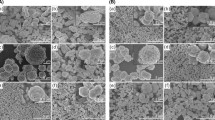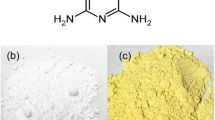Abstract
The synthesis, characterisation, modification (with n-propyl amine groups) of Bi2WO6 particles and the scope for their application in artificial photosynthesis reactions is described. The synthesis involves microwave activation of spherical Bi2O3 precursors followed by a hydrothermal treatment in the presence of Na2WO4. These are characterised using electron microscopy (TEM and SEM), BET, XRD, FTIR, FT-Raman and UV–Visible spectroscopies and CO2 TPD. Subsequently this material is modified through the condensation of propyl amine groups to surface hydroxyl groups, and the composites prepared are characterised using FTIR and D-FTIR following exposure to CO2. Both the spherical particles and the amine-modified analogues are applied in the artificial photosynthesis reaction under batch conditions. O2, CO and CH4 are the observed gaseous products during the reaction and there is FTIR evidence for the formation of adsorbed alcohols and carbonylated products. Although the modification with amine groups decreased the overall photocatalytic reactivity, it also altered the product selectivity with respect to the CH4/CO ratio. The catalyst tends to improve the oxygen production ability after about 20 h of operation, with a decline in CH4 and CO production, indicating that other condensates are probably generated. This opens up new possibilities and scope for this catalyst and further research is required to understand the observations.
Graphic Abstract











Similar content being viewed by others
References
Agency EP (2016) Atmospheric Concentrations of Greenhouse Gases. 1–13
Yamasaki A (2003) An overview of CO2 mitigation options for global warming—emphasizing CO2 sequestration options. J Chem Eng Japan J Rev 36:361–375
Thomas CD, Cameron A, Green RE, Bakkenes M, Beaumont LJ, Collingham YC, Erasmus BFN, Ferreira De Siqueira M, Grainger A, Hannah L, Hughes L, Huntley B, Van Jaarsveld AS, Midgley GF, Miles L, Ortega-Huerta MA, Peterson AT, Phillips OL, Williams SE (2004) Extinction risk from climate change. Nature 427:145–148. https://doi.org/10.1038/nature02121
IPCC (2017) Progress report: IPCC expert meeting on mitigation, sustainability and climate stabilization scenarios. IPCC, Geneva
IPCC (2014) Climate change 2014: synthesis report. Contribution of working groups I, II and III to the fifth assessment report of the intergovernmental panel on climate change. IPCC, Geneva
International Energy Agency (2016) Energy statistics. International Energy Agency, Paris
Albarrán-Zavala E, Angulo-Brown F (2007) A simple thermodynamic analysis of photosynthesis. Entropy 9:152–168. https://doi.org/10.3390/e9040152
Morais E, Ravindranathan Thampi K, Sullivan JA (2020) Photo-dissociation of CO2 over plasmonic RuO2 nanoparticles. ChemistrySelect 5:3069–3074. https://doi.org/10.1002/slct.202000161
Etiope G, Ionescu A (2015) Low-temperature catalytic CO2 hydrogenation with geological quantities of ruthenium: a possible abiotic CO4 source in chromitite-rich serpentinized rocks. Geofluids 15:438–452. https://doi.org/10.1111/gfl.12106
Roy SC, Varghese OK, Paulose M, Grimes CA (2010) Toward solar fuels: photocatalytic conversion of carbon dioxide to hydrocarbons. ACS Nano 4:1259–1278. https://doi.org/10.1021/nn9015423
Kopyscinski J, Schildhauer TJ, Biollaz SM (2010) Production of synthetic natural gas (SNG) from coal and dry biomass—a technology review from 1950 to 2009. Fuel 89:1763–1783. https://doi.org/10.1016/j.fuel.2010.01.027
Alper E, Yuksel Orhan O (2017) CO2 utilization: developments in conversion processes. Petroleum 3:109–126. https://doi.org/10.1016/j.petlm.2016.11.003
Kim C, Hyeon S, Lee J, Kim WD, Lee DC, Kim J, Lee H (2018) Energy-efficient CO2 hydrogenation with fast response using photoexcitation of CO2 adsorbed on metal catalysts. Nat Commun 9:3027. https://doi.org/10.1038/s41467-018-05542-5
Tahir M, Amin NS (2013) Advances in visible light responsive titanium oxide-based photocatalysts for CO2 conversion to hydrocarbon fuels. Energy Convers Manag 76:194–214. https://doi.org/10.1016/j.enconman.2013.07.046
Fan W, Zhang Q, Wang Y (2013) Semiconductor-based nanocomposites for photocatalytic H2 production and CO2 conversion. Phys Chem Chem Phys 15:2632. https://doi.org/10.1039/c2cp43524a
Dhakshinamoorthy A, Navalon S, Corma A, Garcia H (2012) Photocatalytic CO2 reduction by TiO2 and related titanium containing solids. Energy Environ Sci 5:9217. https://doi.org/10.1039/c2ee21948d
Morais E, O’Modhrain C, Ravindranathan KT, James SA (2019) Visible light-driven gas-phase artificial photosynthesis reactions over ruthenium metal nanoparticles modified with anatase TiO2. Int J Photoenergy 2019:1–10. https://doi.org/10.1155/2019/3651603
Green MA, Ho-Baillie A, Snaith HJ (2014) The emergence of perovskite solar cells. Nat Photonics 8:506–514. https://doi.org/10.1038/nphoton.2014.134
Ramirez AP (1997) Colossal magnetoresistance. J Phys Condens Matter 9:8171
Kojima A, Teshima K, Shirai Y, Miyasaka T (2009) Organometal halide perovskites as visible-light sensitizers for photovoltaic cells. J Am Chem Soc 131:6050–6051. https://doi.org/10.1021/ja809598r
Lee MM, Teuscher J, Miyasaka T, Murakami TN, Snaith HJ (2012) Efficient hybrid solar cells based on meso-superstructured organometal halide perovskites. Science 338:643–647. https://doi.org/10.1126/science.1228604
Vashook V, Gerlach F, Guth U, Zosel J, Ahlborn K, Franke D (2008) Perovskite related electrode materials with enhanced NO sensitivity for mixed potential sensors. Solid State Ionics 179:1628–1631. https://doi.org/10.1016/j.ssi.2008.01.044
Hao F, Stoumpos CC, Liu Z, Chang RPH, Kanatzidis MG (2014) Controllable perovskite crystallization at a gas-solid interface for hole conductor-free solar cells with steady power conversion efficiency over 10%. J Am Chem Soc 136:16411–16419. https://doi.org/10.1021/ja509245x
Veldhuis SA, Boix PP, Yantara N, Li M, Sum TC, Mathews N, Mhaisalkar SG (2016) Perovskite materials for light-emitting diodes and lasers. Adv Mater 28:6804–6834. https://doi.org/10.1002/adma.201600669
Stoumpos CC, Malliakas CD, Kanatzidis MG (2013) Semiconducting tin and lead iodide perovskites with organic cations: phase transitions, high mobilities, and near-infrared photoluminescent properties. Inorg Chem 52:9019–9038. https://doi.org/10.1021/ic401215x
Zhao Y, Zhu K (2016) Organic-inorganic hybrid lead halide perovskites for optoelectronic and electronic applications. Chem Soc Rev 45:655–689
Grimaud A, May KJ, Carlton CE, Lee Y-L, Risch M, Hong WT, Zhou J, Shao-Horn Y (2013) Double perovskites as a family of highly active catalysts for oxygen evolution in alkaline solution. Nat Commun 4:2439. https://doi.org/10.1038/ncomms3439
Royer S, Duprez D, Can F, Courtois X, Batiot-Dupeyrat C, Laassiri S, Alamdari H (2014) Perovskites as substitutes of noble metals for heterogeneous catalysis: dream or reality. Chem Rev 114:10292–10368. https://doi.org/10.1021/cr500032a
Xing G, Mathews N, Lim SS, Yantara N, Liu X, Sabba D, Grätzel M, Mhaisalkar S, Sum TC (2014) Low-temperature solution-processed wavelength-tunable perovskites for lasing. Nat Mater 13:476–480. https://doi.org/10.1038/nmat3911
Kendall KR, Navas C, Thomas JK, Zur Loye HC (1996) Recent developments in oxide ion conductors: Aurivillius phases. Chem Mater 8:642–649. https://doi.org/10.1021/cm9503083
Sun S, Chen Z, Wang G, Geng X, Xiao Z, Sun Z, Sun Z, Peng R, Lu Y (2018) Nanoscale structural modulation and lowerature magnetic response in mixed-layer Aurivillius-type oxides. Sci Rep 8:871. https://doi.org/10.1038/s41598-018-19448-1
Kudo A, Hijii S (1999) H2 or O2 evolution from aqueous solutions on layered oxide photocatalysts consisting of Bi3+ with 6s2 configuration and d0 transition metal ions. Chem Lett 28:1103–1104. https://doi.org/10.1246/cl.1999.1103
Chen M, Chu W (2012) Efficient degradation of an antibiotic norfloxacin in aqueous solution via a simulated solar-light-mediated Bi2WO6 process. Ind Eng Chem Res 51:4887–4893. https://doi.org/10.1021/ie300146h
Liu Y, Ding Z, Lv H, Guang J, Li S, Jiang J (2015) Hydrothermal synthesis of hierarchical flower-like Bi2WO6 microspheres with enhanced visible-light photoactivity. Mater Lett 157:158–162. https://doi.org/10.1016/j.matlet.2015.05.024
Sun Z, Yang Z, Liu H, Wang H, Wu Z (2014) Visible-light CO2 photocatalytic reduction performance of ball-flower-like Bi2WO6 synthesized without organic precursor: effect of post-calcination and water vapor. Appl Surf Sci 315:360–367. https://doi.org/10.1016/j.apsusc.2014.07.153
Liang L, Lei F, Gao S, Sun Y, Jiao X, Wu J, Qamar S, Xie Y (2015) Single unit cell bismuth tungstate layers realizing robust solar CO2 reduction to methanol. Angew Chemie - Int Ed 54:13971–13974. https://doi.org/10.1002/anie.201506966
Qamar M, Khan A (2014) Mesoporous hierarchical bismuth tungstate as a highly efficient visible-light-driven photocatalyst. RSC Adv 4:9542–9550. https://doi.org/10.1039/c3ra45948a
Cheng H, Huang B, Liu Y, Wang Z, Qin X, Zhang X, Dai Y (2012) An anion exchange approach to Bi2WO6 hollow microspheres with efficient visible light photocatalytic reduction of CO2 to methanol. Chem Commun 48:9729. https://doi.org/10.1039/c2cc35289c
Liu S-J, Hou Y-F, Zheng S-L, Zhang Y, Wang Y (2013) One-dimensional hierarchical Bi2WO6 hollow tubes with porous walls: synthesis and photocatalytic property. CrystEngComm 15:4124. https://doi.org/10.1039/c3ce40237a
Wang X, Chang L, Wang J, Song N, Liu H, Wan X (2013) Facile hydrothermal synthesis of Bi2WO6 microdiscs with enhanced photocatalytic activity. Appl Surf Sci 270:685–689. https://doi.org/10.1016/j.apsusc.2013.01.121
Fu H, Zhang L, Yao W, Zhu Y (2006) Photocatalytic properties of nanosized Bi2WO6 catalysts synthesized via a hydrothermal process. Appl Catal B Environ 66:100–110. https://doi.org/10.1016/j.apcatb.2006.02.022
Wang Q, Wang K, Zhang L, Wang H, Wang W (2019) Photocatalytic reduction of CO2 to methane over PtOx-loaded ultrathin Bi2WO6 nanosheets. Appl Surf Sci 470:832–839. https://doi.org/10.1016/j.apsusc.2018.11.197
Xiao X, Hu R, Liu C, Xing C, Qian C, Zuo X, Nan J, Wang L (2013) Facile large-scale synthesis of β-Bi2O3 nanospheres as a highly efficient photocatalyst for the degradation of acetaminophen under visible light irradiation. Appl Catal B Environ 140–141:433–443. https://doi.org/10.1016/j.apcatb.2013.04.037
Hou Y-F, Liu S-J, Zhang J, Cheng X, Wang Y (2014) Facile hydrothermal synthesis of TiO2–Bi2WO6 hollow superstructures with excellent photocatalysis and recycle properties. Dalt Trans 43:1025–1031. https://doi.org/10.1039/C3DT52046C
Zhang L, Zhu Y (2012) A review of controllable synthesis and enhancement of performances of bismuth tungstate visible-light-driven photocatalysts. Catal Sci Technol 2:694–706
Zhang L, Wang W, Zhou L, Xu H (2007) Bi2WO6 nano- and microstructures: Shape control and associated visible-light-driven photocatalytic activities. Small 3:1618–1625. https://doi.org/10.1002/smll.200700043
Li J-Q, Guo Z-Y, Yu H-G, Liu H, Wang D-F, Zhu Z-F (2012) Visible-light-induced degradation of methylene blue by mesoporous Bi2WO6 plates with worm-like structure. Micro Nano Lett 7:52. https://doi.org/10.1049/mnl.2011.0642
Kania A, Talik E, Szubka M et al (2016) Characterization of Bi2WO6 single crystals by X-ray diffraction, scanning electron microscopy, X-ray photoelectron spectroscopy and optical absorption. J Alloys Compd 654:467–474. https://doi.org/10.1016/j.jallcom.2015.09.127
Wang Y, Herron N (1991) Nanometer-sized semiconductor clusters: materials synthesis, quantum size effects, and photophysical properties. J Phys Chem 95:525–532
Palimi MJ, Rostami M, Mahdavian M, Ramezanzadeh B (2014) Surface modification of Cr2O3 nanoparticles with 3-amino propyl trimethoxy silane (APTMS). Part 1: studying the mechanical properties of polyurethane/Cr2O3 nanocomposites. Prog Org Coatings 77:1663–1673. https://doi.org/10.1016/j.porgcoat.2014.05.010
Zeynizadeh B, Sepehraddin F (2017) Synthesis and characterization of magnetically nanoparticles of Fe3O4@APTMS@ZrCp2 as a novel and reusable catalyst for convenient reduction of nitro compounds with glycerol. J Iran Chem Soc 14:2649–2657. https://doi.org/10.1007/s13738-017-1199-5
Chattopadhyay DK, Zakula AD, Webster DC (2009) Organic-inorganic hybrid coatings prepared from glycidyl carbamate resin, 3-aminopropyl trimethoxy silane and tetraethoxyorthosilicate. Prog Org Coatings 64:128–137. https://doi.org/10.1016/j.porgcoat.2008.09.008
Vieira RB, Pastore HO (2018) Soft-pillared@magadiite: influence of the interlayer space and amine type on CO2 adsorption. Dalt Trans 47:3102–3111. https://doi.org/10.1039/c7dt03732e
Wang X, Song C (2012) Temperature-programmed desorption of CO2 from polyethylenimine-loaded SBA-15 as molecular basket sorbents. Catal Today 194:44–52
Huang HY, Yang RT, Chinn D, Munson CL (2003) Amine-grafted MCM-48 and silica xerogel as superior sorbents for acidic gas removal from natural gas. Ind Eng Chem Res 42:2427–2433. https://doi.org/10.1021/ie020440u
Graves PR, Hua G, Myhra S, Thompson JG (1995) The Raman Modes of the Aurivillius phases: temperature and polarization dependence. J Solid State Chem 114:112–122. https://doi.org/10.1006/jssc.1995.1017
Riegel B, Hartmann I, Kiefer W, Groβ J, Fricke J (1997) Raman spectroscopy on silica aerogels. J Non Cryst Solids 211:294–298. https://doi.org/10.1016/S0022-3093(96)00639-4
Guo Y, Zhang G, Gan H (2012) Synthesis, characterization and visible light photocatalytic properties of Bi2WO6/rectorite composites. J Colloid Interface Sci 369:323–329. https://doi.org/10.1016/j.jcis.2011.11.066
Acknowledgements
EM is funded by Coordenação de Aperfeicoamento de Pessoal de Nível Superior (CAPES) through the ‘Science without Borders (SwB) scheme’ supported by the Brazilian Ministry of Education.
Author information
Authors and Affiliations
Corresponding authors
Additional information
Publisher's Note
Springer Nature remains neutral with regard to jurisdictional claims in published maps and institutional affiliations.
Electronic supplementary material
Below is the link to the electronic supplementary material.
Rights and permissions
About this article
Cite this article
Morais, E., Stanley, K., Thampi, K.R. et al. Scope for Spherical Bi2WO6 Quazi-Perovskites in the Artificial Photosynthesis Reaction—The Effects of Surface Modification with Amine Groups. Catal Lett 151, 293–305 (2021). https://doi.org/10.1007/s10562-020-03299-5
Received:
Accepted:
Published:
Issue Date:
DOI: https://doi.org/10.1007/s10562-020-03299-5




